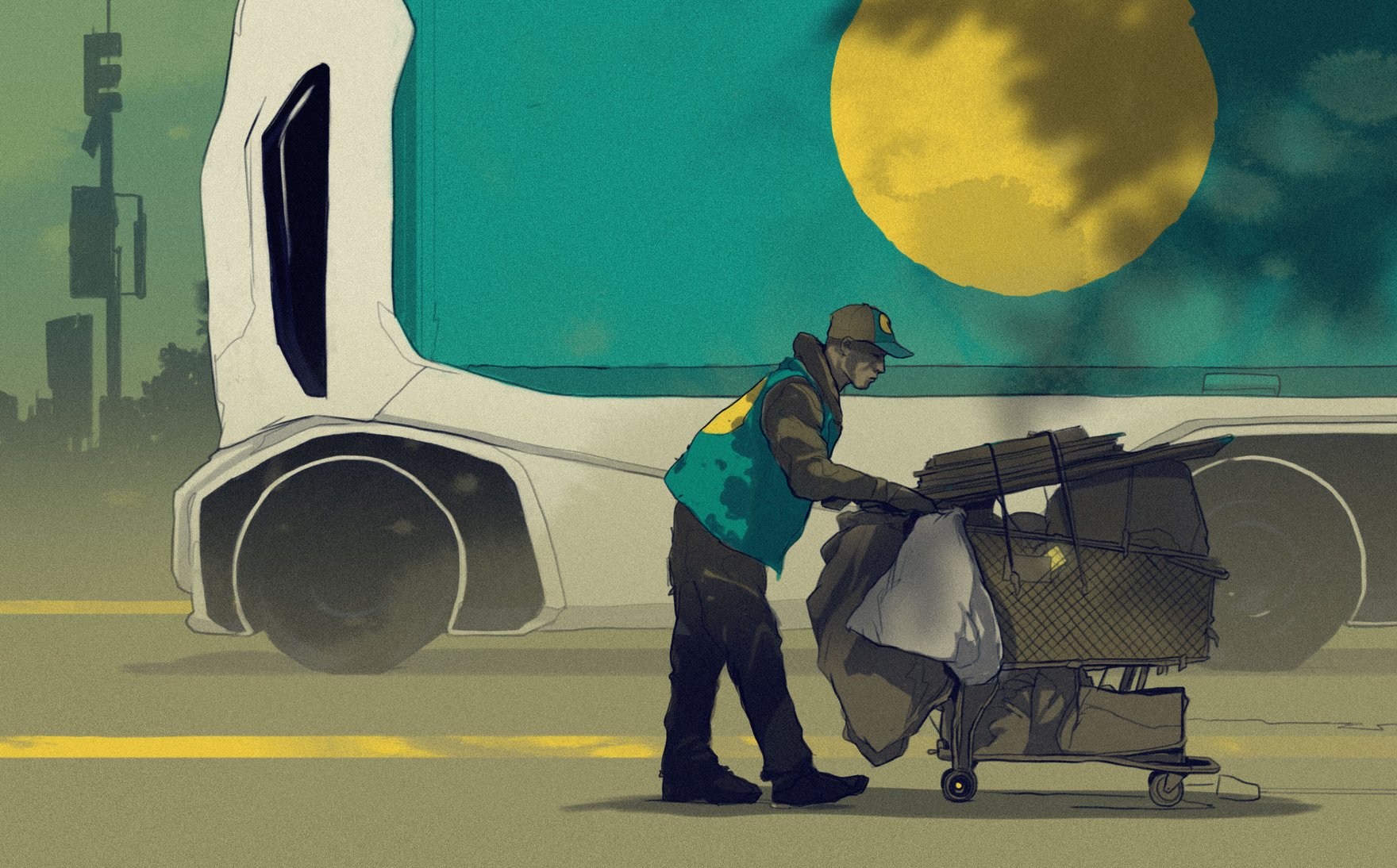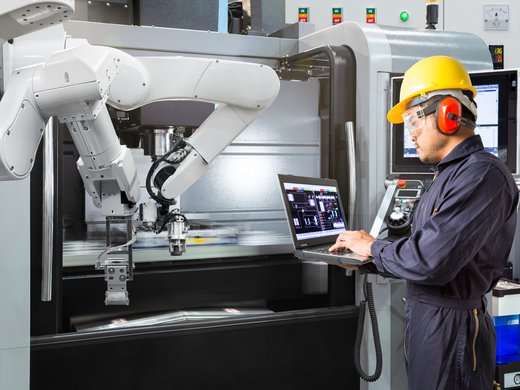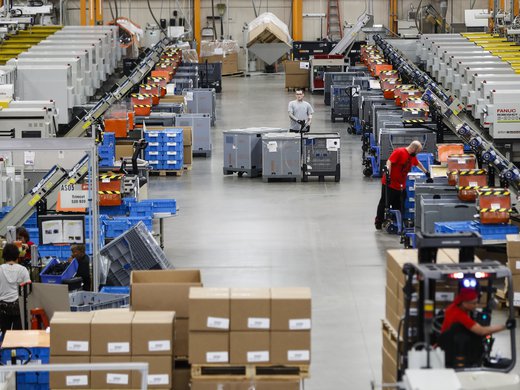Geopolitical crises, looming climate chaos and the relentless expansion of surveillance capitalism are driving the development of the technologies of tomorrow — artificial intelligence (AI), semiconductors, green energy, big data, advanced robotics, virtual and augmented reality, nanotechnology, quantum computing, the Internet of Things and more.
Each of these tools holds tremendous potential to improve lives and help solve the world’s biggest problems. But technological change always produces winners and losers by giving rise to new concentrations of power and novel forms of inequality. For example, a study by the US National Bureau of Economic Research found that between 50 and 70 percent of lost wages in America from 1980 to 2016 stemmed from automation — far more than from aggressive offshoring or the withering of labour unions.
However, automation has brought about new occupations as well, evidenced by the absence of mass joblessness in the United States over the same period. Despite the lost wages, the US unemployment rate from 1993 to 2019 stayed around or below seven percent when excluding a four-year recovery following the exogenous shock of the 2008 financial crisis. Productivity has also increased by nearly 62 percent since 1979. But the wages of American workers have failed to keep pace, rising only 17.5 percent, signalling a deep disconnect in recent history between new technologies being adopted and the average worker being better off as a result.
Similar circumstances across the democratic world have provoked severe political consequences over the past decade. Disaffected populations caught on the wrong side of economic transformations and alienated by the accompanying social changes spurred by globalization have aligned themselves with populists pitching simplistic solutions to complex problems. Polarization has skyrocketed; international cooperation has frayed.
As the so-called Fourth Industrial Revolution accelerates in coming years, upending how economies and societies operate, a new form of populism rooted in tech-fuelled disparities may eventually consume democratic nations. To avoid this outcome, governments must get serious about harnessing new technologies to make the democratic process more agile and responsive to voters’ frustrations.
The Coming Age of Disruptive Automation
Since researchers at Oxford University published a landmark study in 2013 estimating that some 47 percent of total US employment was at risk of automation, fears over the prospect of mass displacements of human labour by new technologies have grown. They have also become more urgent in the wake of the pandemic. According to one assessment, the first several months of the COVID-19 pandemic in 2020 fast-tracked four years’ worth of digital adoption in business operations and supply chains, and seven years’ worth of investment into digital-based products.
American academic Erik Brynjolfsson has noted that when it comes to technology’s job-creating potential, past trends are not necessarily guaranteed to play out in the future. “Improvements in technology can improve productivity. For most of the 20th century, those productivity increases were associated with job growth and growing wages. But there is no economic law saying that always has to be the case.”
That seems to hold true when looking at the six largest tech companies in the world — Apple, Microsoft, Alphabet (Google’s parent company), Amazon, Tesla and Meta. As of early October, with a combined market valuation of nearly $8 trillion — a bit less than half the GDP of China, the world’s second-largest economy — they collectively employed just 2.25 million people, significantly less than the US federal government. And at least 1.5 million of that total comes from Amazon, which launched an ill-fated pandemic hiring binge and has routinely come under fire for poor working conditions for its staff.
When it comes to digital products being created by tech companies, Beijing-based venture capitalist Kai-Fu Lee predicted in 2017 that AI would replace half of all human labour before 2030. That same year, a report by the McKinsey Global Institute appeared to corroborate Lee’s ominous forecast. After analyzing 2,000 different work responsibilities across 800 different job roles, McKinsey suggested “about half the activities people are paid almost US$15 trillion in wages to do in the global economy have the potential to be automated by adapting currently demonstrated technology.”
While only five percent of the occupations analyzed by McKinsey could, in theory, disappear entirely, technological progress has accelerated. Clearly, some jobs are in greater jeopardy than others. The positions most susceptible to automation are based on physical activities in highly structured and predictable environments, or the collection and processing of data, say the report’s authors. Among those most vulnerable are low-skilled positions in manufacturing, hospitality and retail commerce. The report claims that “technical, economic and social factors will determine the pace and extent of automation,” but that half of contemporary work activity could be automated by 2055, possibly even as soon as 2035.
Others offer a more upbeat assessment, saying AI and automation will create more jobs than they threaten by producing future occupations yet to be imagined.
Analysis published in October 2020 by the World Economic Forum — several months after the pandemic was declared, once companies had had time to evaluate the need and opportunities for increased automation — predicted that by 2025, “a shift in the division of labour between humans and machines” might eliminate 85 million jobs, while also creating 97 million new ones. Such positions would see work functions split more evenly between humans, machines and algorithms; machines would handle more physical tasks while algorithms could simplify and augment human-based inputs and decision-making processes.
However, while 12 million net new jobs sounds positive, context is important. Ensuring that workers displaced by technology can avoid joblessness by transitioning to new roles will require re-skilling on an enormous scale, at a considerable cost and in an ever-shrinking window of time. For comparison, governments have so far mostly failed in producing credible plans for a “just transition” for a much smaller and more predictable number of fossil fuel workers poised to lose out as the world shifts to alternative energy sources. A decrease in human labour’s share of work responsibilities could also suppress wage growth.
Another sector ripe for disruption by automation is transportation, which accounts for approximately 29 workers per 1,000 people in the European Union. Trucking could be hit particularly hard, affecting more than 2.2 million drivers in the United States and hundreds of thousands of workers in Canada. Self-driving vehicles in the freight industry are already being road-tested, with proponents saying autonomous trucks will not only be safer but also reduce shipping operator costs by 40 percent due to not having to hire a human driver. The vast majority of those human drivers, according to labour market research company Zippia, are white males over 48 years old with lower levels of education. Truck-driving is also the highest-paid “low-skilled” large labour segment remaining in the North American economy.
Elsewhere, large AI language models, systems that understand and generate text, will eventually compete for millions of low-skilled jobs involving a range of customer support services. Existing models can already provide strikingly accurate and original responses to human interaction — so much so that Google researcher Blake Lemoine caused widespread alarm this past June by claiming that a chatbot based on Google’s LaMDA model had become sentient. Lemoine was later let go by the company.
The capabilities of LaMDA and its rivals, such as OpenAI’s GPT-3 — which wrote an op-ed for The Guardian in September 2020 — and Meta’s free version, OPT-175B, will expand exponentially as they incorporate audiovisual material into their data training sets. Right now, these training sets consist only of huge troves of text scoured from across the internet. Moreover, user-friendly machine-learning models such as OpenAI’s Dall-E and those from Midjourney AI are producing increasingly sophisticated computer-generated art and illustrations, while others are generating music. Both will likely eliminate career opportunities in the creative industries.
The impacts of technology will also upset social relations in other ways that can exacerbate culture wars and grievance politics.
For example, cloud computing and better virtual reality for use in business meetings will provide white-collar workers with ever-greater job flexibility, just as climate change renders blue-collar jobs much more dangerous. This may entrench the sort of contentious digital divide and risk imbalance experienced between office staff and front-line workers during the pandemic.
Meanwhile, consumer biotechnology will enable the well-educated and wealthy to live longer, healthier lives that will extend their working careers, possibly narrowing opportunities for young people and new graduates. At the same time, wider adoption of pre-crime and predictive policing tools could aggravate the discrimination and stigmatization already felt within disadvantaged communities. Policies that successfully attract tens of thousands of skilled immigrants to plug labour gaps in the tech sector could inflate local housing prices.
Many thinkers are also already confronting questions about when and how — not if — intelligent machines could be granted some equivalent to human rights.
In his book Homo Deus: A Brief History of Tomorrow, Israeli historian Yuval Noah Harari extrapolates even further. He posits that if this century’s technological advances — and the quasi-religious zeal attached to those gains — mean citizens in liberal democracies eventually cede much of their military and economic usefulness to robots and algorithms, the political system “will stop attaching much value to them.” The result, according to Harari, would be an erosion of the core liberal belief that each human, as an individual, holds intrinsic value and deserves to exercise choice through democratic elections and free markets.
Should these scenarios come true, they are likely to worsen the already growing bifurcation within democratic politics — a split between those who believe in open economies and societies, and those seeking primacy for their chosen social and political tribes.
The prolonged, uneven fallout of the 2008 financial crisis has already catapulted populist leaders with zero-sum ideologies to various levels of office in democratic nations across the world.
Populism Reinvented
The prolonged, uneven fallout of the 2008 financial crisis has already catapulted populist leaders with zero-sum ideologies to various levels of office in democratic nations across the world. Everywhere, their base of support is comprised of voters demanding retribution against an undefined set of “elites” perceived as clinging unfairly to the top of the socioeconomic ladder.
Indeed, the meritocracy and promise of social mobility that have historically underpinned liberal democracies seem to be faltering. In 2017, Massachusetts Institute of Technology economist Peter Temin laid out an argument that escaping poverty in America takes 20 years of effort combined with uninterrupted good luck. Income inequality among member countries of the Organisation for Economic Co-operation and Development prior to the pandemic was already at its highest levels in five decades, much of it due to the disappearance of middle-class job opportunities.
More recently, a report from the UN Development Programme released in September warned that “in a stunning first,” cascading global crises had so impacted life expectancies, education levels and quality of life worldwide that its Human Development Index — a broad country-by-country measurement of human progress — had declined for two years in a row, a change equivalent to “erasing the gains of the preceding five years.”
The latest annual World Inequality Report, produced by the Paris-based World Inequality Lab, sheds light on where these losses are being felt (and perceived) the most — the middle and working classes of wealthy nations. The past two decades of globalization have narrowed inequality between rich countries and the developing nations, while simultaneously increasing inequality within countries themselves. “This sharp rise in within country inequalities has meant that despite economic catch-up and strong growth in emerging countries, the world remains particularly unequal today. It also means that inequalities within countries are now even greater than the significant inequalities observed between countries.”
The resulting angst is being channelled into democratic societies in visible and distressing ways — from online conspiracies and extremism to the embrace of political violence and victimhood as a source of identity and personal meaning. In short, many people in the Western world in particular are increasingly unable to deal with the dissonance between their subjective expectations for their lives and the objective material realities they must contend with.
In 2022, the legacies of pandemic lockdowns and vaccine mandates, combined with a global energy crisis and red-hot inflation eating away at individuals’ purchasing power, are breathing new life into populist movements. And different types of tech-focused populists are emerging to harness this maelstrom of inequality, rage and technological advancement as a pathway to power.
Among them are Republican Missouri Senator Josh Hawley, author of a book entitled The Tyranny of Big Tech. In vowing to “fight to recover America’s populist democracy,” Hawley epitomizes a growing number of ideologues and reactionaries, on the far right and far left both, who instinctively point to Google, Amazon, Facebook and Twitter as the cause of a whole range of modern ills, no matter how tenuous the connection.
Conversely, the new leader of Canada’s opposition Conservative Party, Pierre Poilievre, has embraced technology’s potential for circumventing established institutions. An outspoken ally of the so-called “freedom convoy” that drew international attention for its weeks-long occupation of downtown Ottawa earlier this year, Poilievre won the Conservative leadership contest by a record margin by promising to make Canada the “freest country on Earth” via downsizing government and eliminating “gatekeepers.” This included Poilievre’s pledge to fire the governor of the Bank of Canada, which he made while avidly promoting cryptocurrencies because, he says, “Canada needs less financial control for politicians and bankers and more financial freedom for the people.” (Poilievre has noticeably toned down his public comments around cryptocurrencies after their recent crash.)
However, while leaders of populist movements routinely rail against the excesses of government while in opposition, once they’re elected, manipulating the levers of state power tends to become central to executing their broader agenda. In that light, tech-savvy populists may eventually look to emulate the “techno-authoritarianism” of Brazil’s President Jair Bolsonaro, or of India’s Prime Minister Narendra Modi, whose Hindu nationalist government has been accused of encouraging citizens’ enrolment in India’s voluntary biometric ID system — the world’s largest, known as Aadhaar — as a means of gathering information needed to enact exclusionary populist policies that favour Modi’s Hindu nationalist base.
Governments must be more honest and direct around the inevitable dangers of technological disruption that lie ahead, and the limits to how it can be addressed.
Getting Technology to Serve the Aspirations of Democracy
To harness the benefits of new technology and mitigate and cope with some of their harms, governments themselves need to make better use of technology to strengthen the democratic process.
One example comes from how President Emmanuel Macron’s government responded to the grassroots “gilets jaunes” (yellow vest) protest movement, which paralyzed much of France throughout 2018 as low-wage workers violently resisted fuel price hikes meant to reduce carbon emissions. In 2019, Macron announced the creation of citizen assemblies to directly advise bureaucrats on climate measures that wouldn’t disproportionately burden the middle and working classes. Such fora can and should be more widely used by governments everywhere, on a host of issues, through the use of creative digital methods.
Other relevant initiatives could include efforts to demystify AI to help the average citizen feel more empowered to voice concerns and participate in society. Strengthening transparency rules alongside shrewd digital services legislation will put pressure on tech companies to better act in the public interest and more adequately protect consumers. Greater enforcement of antitrust laws would also prevent, or at least slow, the lightning-fast acquisitions that occur as soon as start-ups emerge as legitimate challengers to incumbent monopolies. Government agencies must devise carrot-and-stick incentives for private firms, researchers and engineers developing AI programs to demonstrate application of effective AI governance strategies. Their funding for research into platform governance should be expanded, too.
At the international level, American political scientist Ian Bremmer, president and founder of the Eurasia Group, has advocated for the creation of an intergovernmental body similar to the UN Intergovernmental Panel on Climate Change to examine and address the global risks of runaway AI becoming decoupled from serving human interests. This echoes CIGI’s vision for a Digital Bretton Woods.
All of this requires a return to serious politics. Governments must be more honest and direct around the inevitable dangers of technological disruption that lie ahead, and the limits to how it can be addressed. Electorates also need to know there are inherent trade-offs in the imperfect solutions that are emerging. One such solution is placing higher taxes on businesses that adopt technologies that intentionally make human labour redundant — even though that would hinder desirable productivity growth by creating an added barrier to capital investment. Calls for a universal basic income will also surely grow louder, despite the scheme’s prohibitive cost.
In a recent interview, Rob Reich, associate director of Stanford University’s Institute for Human-Centered AI, argued that “the policy window is just now opening for ten, twenty years in which we’re going to have various ways to try to contain the socially undesirable consequences of this big tech age. The question is whether our policy makers are up to the task.”
It’s no exaggeration to say the future of democratic politics may depend on it.
A version of this piece has appeared in Newsweek.



